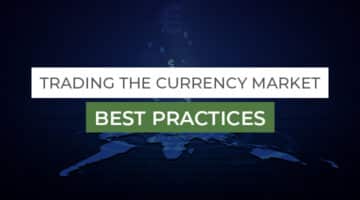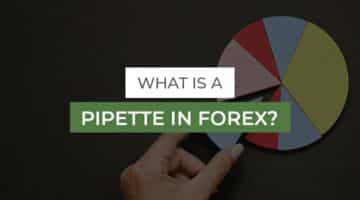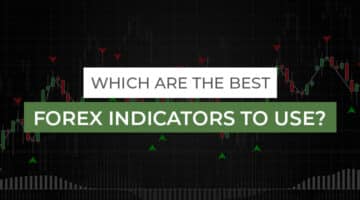What is Leverage in Forex?

In this article
Have you opened a new trading account and want to understand Leverage in Foreign exchange?
Leverage is one of the most powerful and alluring aspects of choosing to trade Forex over most other asset classes. But what actually is Leverage in Forex and how can you use it to your advantage?
Leverage allows a Forex trader to essentially borrow money from your broker, for the purpose of controlling a larger position than you could otherwise trade. Through what is essentially a loan from your broker, Leverage allows you to use a fraction of your own money, while still being able to trade much bigger volumes than you otherwise could.
An example of how Leverage works in Forex:
Leverage is expressed in ratios, such as 1:100.
Using the leverage ratio of 1:100, you would only need $1,000 in your retail investor accounts to control a $100,000 position.
This $1,000 in your account is what’s known as a forex margin. Essentially a good faith deposit is made to your broker before they stump up the rest needed to take the larger position.
In this blog, we go over the benefits, and risks and discuss why you need to focus on high-risk management rather than simply bumping up your Leverage.
Does Leverage in Forex Increase Trading Profits?
No, Leverage itself alone doesn’t increase your forex trading profits. Don’t be ridiculous, leverage is not some magic wand that waves across your Forex broker’s account and makes you money. Taking personal responsibility for your strategy and risk management rules is the most important factor when trading on Leverage.
To show how Leverage affects your forex trading profits, let’s revisit the example we spoke about above:
So as we already showed, to control a $100,000 position using a Leverage of 1:100, you only need $1,000 in your account as a margin. The rest is fronted by your broker, essentially loaning it to you so you can trade respectable size in the 5.1 trillion dollar-a-day forex market.
Without Leverage, if you had invested virtual funds that entire $100,000 of your own and its value had appreciated to $101,000, then congratulations, you would have made a 1% return on your investment. While profit is profit, that’s not the sort of return we trade Forex for, is it?
But as your Forex broker offered you forex leverage of 1:100, allowing you to control a $100,000 position while only trading $1,000 of your own money as the required margin, you’d have now made a 100% return. Now that’s more like it.
Forex Leverage is a Double-Edged Sword
But if something is too good to be true, then it probably is. We’re sure you’ve heard the saying. Well, the risk involved in over-leverage put new traders into serious trouble. Learn how to calculate swaps in Forex also learn how to calculate Leverage in Forex.
Maximum Leverage in Forex trading truly is a double-edged sword. While we could feel you cringing through the screen as you read that bashful cliche, it’s a fact that simply had to be stated for your own well-being. If you’re not careful, then Leverage will do more harm than good to your psychology and, most importantly, your trading account balance.
This is because if we use the above example for a third time, only this time picturing your position moving against your $1,000 (shudder), you would have also lost 100%. That’s right; your entire investment is gone in a few financial market moves.
You can read about what Leverage is inside forex blogs just like this one and technical analysis, but you probably won’t understand until you’ve experienced the highs and lows on a forex trading account yourself, you probably won’t understand.
It is quite normal to use Leverage when trading the futures market. It is very powerful to use Leverage when used correctly and appropriately against forex market moves. It can, however, destroy your future performance in no time if it is used incorrectly.
For this reason, we encourage you to open a small live account rather than a demo account in order to really feel what Leverage does to your account and, most importantly, your psychology.
Why Do Brokers Offer Leverage in trading?
After learning what Leverage is and how it works, you may wonder why brokers offer Leverage to their customers.
Trading fees are how brokers make their money, and, simply put, the bigger the position, the more fees they earn. A Forex brokers’ income is derived from commissions (if any) and the spread – an essential source of income.
If a leveraged position is left open overnight, it will incur an interest charge known as a swap. Different fees depend on which asset you are trading and which broker you use. Likewise, swap fees are charged at different times of the day, depending on the broker. On the broker’s trading platform, you’ll find information on swap fees or by using a trading calculator (which will also calculate your Forex leverage and margin).
What is the advantage and disadvantage of Leverage in trading?
No surprise, Leverage can be its greatest benefit and greatest liability. Forex leverage allows traders to magnify their potential profits when FX markets move their way. Any unfavourable FX market movement can, however, magnify losses.
Therefore, an active investor should use Leverage with great care and caution since it can have devastating effects on their finances. Trading the financial markets requires high risk management, which is why all new traders must practice. Furthermore, new traders can use their trading capital for other investments or trades as a potential profit from trading leverage.
What Is the Maximum CFD Leverage in trading?
The European Securities and Markets Authority (ESMA) in the EU and the Financial Sector Conduct Authority (FSCA) in the UK imposed limits on retail CFD leverage in 2018. In both jurisdictions, retail traders are limited to Leverage of 1:30 or 1:2, depending on the asset class. With an authorised financial services provider, professional traders can get Leverage up to 1:500, higher than the Leverage available to retail traders.
How to Choose the Best Leverage Level in trading?
Which leverage level is best? There is no easy way to determine the appropriate level of Leverage. Because it is mainly dependent on the trading strategy of the trader and the actual vision of how the market will move in the future, positional traders, on the other hand, usually trade with low Leverage. In contrast, scalpers and breakout traders usually try to use high Leverage. What is the best Leverage for forex trading? Remember that Forex traders should choose a leverage level that suits their needs.
Leverage in Forex Trading
On average, an online broker offers Leverage between 1:400 and 1:1000. It is generally recommended to trade Forex at a leverage level of 1:100 when trading Forex. Using the Leverage of 1:100, $1000 invested will yield a total value of $100.000 if the Leverage is equal to 1:100. More precisely, traders can trade currencies with higher volumes because of Leverage. Small borrowed capital investors prefer margin trading (or Leverage) because their deposits are insufficient for opening positions.
Among Forex traders, 1:100 is the most popular leverage ratio.
In what way is high Leverage problematic in trading? Besides being attractive, high Leverage comes with high risk. For newcomers to online trading, Leverage may pose a problem for those who are merely interested in making potential profits while neglecting the fact that they will also experience massive losses.
How Margin and Leverage are Linked?
The purpose of margin trading is to increase the buying power of an investor. To open a much larger position, investors only need to put up a fraction of the funds they would normally need. A percentage of the position’s value is called the initial investment margin, and you don’t need to pay the full value of the position.
A Retail Client who trades on margin may benefit from it, but it is also high-risk because it is possible to lose the entire investment. Professional clients may be at risk of losing money more than their deposits, and additional funds may need to be deposited to cover those losses. Leverage equals the multiple exposures to account equity multiplied by a margin, and margin is the amount of margin required to open a position. It depends on the margin rate requirements and how much margin percentage is required. Based on the volatility and liquidity of the underlying forex market, this varies between trading instruments.
The initial margin is the amount put up when opening the position. Also known as an “initial deposit,” it is the first payment received by the investor. Different markets will require different initial margins depending on the type of asset, the trading instrument, and the trade size. Margin calls prevent you from taking on any additional risk, leading to your account being stopped.
If your equity (balance minus unrealized profit and loss) equals your margin requirement, you are on a margin call. Once your equity reaches half of your margin requirement, you will be forced to close out your biggest losing position. A trader’s account would be at risk of being stopped if they have open losing positions and insufficient equity to cover them. If the balance drops below the margin stop-out level, any or all of their open positions would be automatically closed. According to the 90% margin close-out rule, each account must meet the rule.
The current close-out percentage on a Trader trading account is 90%, meaning he has six open trades requiring $200 worth of position margin. A total value of $1,200 would be required as position margin. Some or all of those trades may be automatically closed out if the Trader’s margin drops below 90% (which, in this example, is $1,080).
If a trader receives a margin call, they have two options. The first option would be to close the position immediately. If your equity falls below the margin requirement, you should deposit more funds to support further losses. To free up more equity in the account, you can also reduce the size of other positions.
Risk Management is Still the Key to Profitable Forex Trading
The most important aspect of using Leverage in Forex is using what your broker offers you effectively. This means remaining a risk manager first and foremost and sticking to the guidelines laid out in your trade plan.
In order to do this effectively, never risk more than 2% of your account’s equity on any single trade and make sure you’re taking positions that offer excellent risk-reward ratios. By keeping your risk low and allowing your winning trades to run, you’ll put yourself in a much greater position to become consistently profitable than if you just maxed out your Leverage and gambled on 50/50 moves.
Remember, just because you have access to Leverage of 1:400 or more, doesn’t mean you have to use all of your available margin on any single trade. Instead, consider using a position size calculator tool to ensure you’re always sticking within your 2% risk parameters and not gambling your entire account on a single move.
If you want to leverage up and gamble on a single move, you honestly may as well just go down to the casino and put it all on red. At least that way, you’ll get a few free drinks out of the experience!
Key Risk Management tools
The high risks involved in Leverage should be managed in the following ways:
- With trailing stops,
- Minimizing positions
- By limiting capital per position, companies can manage their risk.
As a result, Forex leverage can be successfully and profitably used with proper management
Key takeaways leverage
In conclusion, while leveraging Forex to scale up your profits quickly can be tempting, the key to becoming a consistently profitable trader is employing conservative risk management tactics as a part of your foreign exchange trading strategy.
After reading about what is Leverage in Forex, forex traders should now realize that the leverage ratios offered by your broker aren’t going to make you rich alone. Instead, they have the potential to really set you up for failure and on the path toward a dreaded margin call.
There is no right amount of forex leverage that you should use to be successful, but there is a wrong amount of risk. No matter your forex leverage on offer, always adjust your position size to only risk 2% of your account equity per trade.
You won’t double your account overnight, but by managing risk effectively, you will stay in the game long enough to double it many times over in the long run. Forex trading is a long-term game with a huge risk of losing money.
Jason Morgan is an experienced forex analyst and writer with a deep understanding of the financial markets. With over 13+ years of industry experience, he has honed his skills in analyzing and forecasting currency movements, providing valuable insights to traders and investors.
Forex Content Writer | Market Analyst
Relevant Posts

Bar Candles Explained
[top_three_brokers] We are sure you probably have heard about the forex candlestick patterns. But, along…
Read more

Line Graph Explained
[top_three_brokers] In forex trading, there are different types of charts that help you visualise price…
Read more

MetaTrader 6
MetaTrader 6 Release Date - Upgrade from MetaTrader 5? Beginners to professional traders have been…
Read more

Trading the Currency Market – Best Practices
[top_three_brokers] Trading the currency market can seem like a daunting task if you don't know…
Read more

What is Spread in Forex?
[top_three_brokers] One of the most fundamental topics is knowing what is the Spread in Forex?…
Read more

What is a Pipette in Forex?
[top_three_brokers] When we get into a conversation about Forex trading, you will come across different…
Read more
What is KYC when opening a Forex Trading Account?
Know Your Customer/Client (KYC) is a term used in financial services and trading platforms to…
Read more

Which are the Best Forex Indicators to Use?
[top_three_brokers] If you are new to forex trading, technical analysis can be like solving a…
Read more

Forex Reversal Patterns Explained
[top_three_brokers] Have you ever come across a situation when the market changes its course, and…
Read more

Forex Continuation Patterns
[top_three_brokers] The trading world is all about anticipating what's going to happen. Then, based on…
Read more

Bar Candles Explained
[top_three_brokers] We are sure you probably have heard about the forex candlestick patterns. But, along…

Line Graph Explained
[top_three_brokers] In forex trading, there are different types of charts that help you visualise price…

MetaTrader 6
MetaTrader 6 Release Date - Upgrade from MetaTrader 5? Beginners to professional traders have been…

Trading the Currency Market – Best Practices
[top_three_brokers] Trading the currency market can seem like a daunting task if you don't know…

What is Spread in Forex?
[top_three_brokers] One of the most fundamental topics is knowing what is the Spread in Forex?…

What is a Pipette in Forex?
[top_three_brokers] When we get into a conversation about Forex trading, you will come across different…
What is KYC when opening a Forex Trading Account?
Know Your Customer/Client (KYC) is a term used in financial services and trading platforms to…

Which are the Best Forex Indicators to Use?
[top_three_brokers] If you are new to forex trading, technical analysis can be like solving a…

Forex Reversal Patterns Explained
[top_three_brokers] Have you ever come across a situation when the market changes its course, and…

Forex Continuation Patterns
[top_three_brokers] The trading world is all about anticipating what's going to happen. Then, based on…


